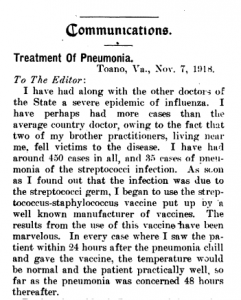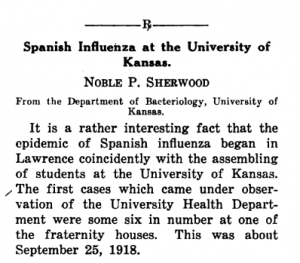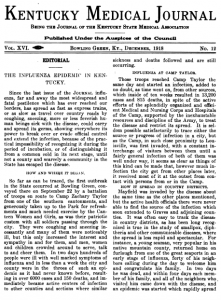~This is the second of four guest posts from a class taught by Tom Ewing at Virginia Tech in fall 2017. Read the other parts here: I and III.
Students enrolled in Virginia Tech’s course, Introduction to Data in Social Context, in fall 2017 were assigned a group project requiring them to complete a case study of a single state during the Spanish influenza using a variety of primary sources. (1) Six states were selected for the groups: Pennsylvania, Virginia, Kentucky, Indiana, Missouri, and Kansas. These states each had a medical journal available from this collection and they were contiguously linked geographically, which allowed for comparisons of regional similarities and differences. The total population of these six states was approximately 20 million, which made up one-fifth of the total United States population (105 million, according to the 1920 census) which means that these states can be considered a broadly representative section of the population. (2) Each group was asked to consider three types of primary sources in preparing their case study: 1) newspapers published in 1918 and available from the Library of Congress Chronicling America collection (3); 2) data from the United States Census on causes of death during the year 1918 (4); and 3) one article from the state medical journal. The assignment was designed to encourage students to think about data as an important aspect of historical analysis, to learn how to find data in original historical documents, and to interpret this data using a combination of written text, visual representations, and oral presentations. The groups spent about four weeks on this project, producing a short presentation (link) and multiple drafts of a short analytical essay.
The six articles from the state medical journals assigned to research teams were selected to illustrate the breadth of reporting on the Spanish influenza available for scholars and students conducting research on the Spanish influenza. (5) The lead article in The Journal of the Indiana State Medical Association in the June 15, 1919 issue, offered a specialized review of bacteriological cultures taken from identified victims of the Spanish influenza. Authored by Virgil H. Moon, a physician in the Department of Pathology at the Indiana University School of Medicine, this article was apparently written for the expert readers of this medical journal, thus demonstrating how medical journals provided a forum for circulating research within the profession with the goal of advancing knowledge about causes of disease. The fact that this article was first presented to the Marion County Medical Society on December 3, 1918 provides further evidence of how state medical journals contributed to the circulation of expert knowledge, as a paper initially presented orally to colleagues became part of the published record available to the medical community throughout Indiana — and now available digitally to scholars and students.
An article published in the Virginia Medical Monthly in December 1918, written by Doctor H. U. Stephenson, also sought to use the forum of a medical journal to spread knowledge about the Spanish influenza. (6) In this article, Dr. Stephenson used his own record of treating influenza patients to make broad claims about the effectiveness of an anti-influenza vaccine. This article suggests that state medical journals also functioned as a way for individual physicians to share their experiences with colleagues and thus disseminate knowledge gained through direct medical practice. In this case, the fact that the article appeared in December 1918, within weeks of the peak of the influenza epidemic, illustrates how state medical journals provided timely reporting on the experience of physicians in ways that might be most useful for the profession. In addition, the fact that Dr. Stephenson practiced in a small town in a rural part of the state indicates that the journal served the function of connecting medical professionals located in a variety of locations that may not have otherwise been served by a medical society or medical school in close proximity.
Also in December 1918, the Pennsylvania Medical Journal re-published a letter that had first appeared in the Philadelphia Evening Ledger on October 22, 1918, written by Marion E. Smith, Superintendent of University Hospital. (7) The letter, published soon after Philadelphia experienced the most deadly stage of the influenza epidemic, expressed heartfelt gratitude to the entire staff of the hospital for their dedication to patients, colleagues, and the community. Publishing this letter from the newspaper in the state medical journal brought the experience of this hospital to the attention of the broader medical profession in Pennsylvania while also providing historians with a vivid first-hand description of the impact of the disease on medical professionals including nurses, housekeepers, and cooks at a major urban hospital.
In December 1918, the Journal of the Kansas Medical Society published a report on
Spanish influenza at the University of Kansas authored by Noble P. Sherwood of the Department of Bacteriology. (8) The article, published less than two months after the epidemic hit the campus, provided a detailed account of the epidemic, including the number of patients,, leading to the conclusion that the prompt and extensive treatment offered by hospital and university staff explained the “comparatively low death rate.” Articles that examines the course of the disease within a particular community, often written by those with direct experience during the epidemic, provided colleagues with detailed descriptions of patients, physicians, nurses, and hospitals, that can now be used by scholars and students to document both the impact of the influenza and the ways that medical professionals at the time devised, and evaluated, treatment options.
In March 1919, approximately six months after the epidemic, the Journal of the Missouri State Medical Association published a short article about the influenza epidemic at Jefferson Barracks, authored by Major Louis M. Warfield, which provided a detailed account of the number of cases and deaths and the measures taken by the hospital staff. (9) Major Warfield presented this information at the December 9, 1918 meeting of the Missouri State Medical Association, and the version published in the state medical journal included the discussion that followed at the meeting, with extensive comments from one speaker identified only as Dr. Dock. The publication of papers from the state medical association meetings, and particularly the discussions that followed, reveal the important role of state medical journals in promoting scholarly and scientific exchanges within the medical profession, particularly during and immediately after an unexpected and costly health crisis. For historians, these exchanges are especially valuable because they illustrate the evolution of professional understanding of this disease and the measures taken to treat patients.
In December 1918, the Kentucky Medical Journal published an editorial with the title, “The Influenza Epidemic in Kentucky,” which traced the disease from the first outbreak near the city of Bowling Green following a visit by a battalion of troops on their way to Camp Zachary Taylor. (10) After examining several similar examples of rapid and extensive disease transmission, the editorial concluded with recommendations to prevent similar outbreaks in the future, including a lengthy excerpt from recommendations by the Health Commission of New York. This editorial demonstrates the value of state medical journals for understanding the scope and scale of a disease outbreak within a particular state as well as the important role of journals in re-printing materials from other journals, thus ensuring they reached the important audience of medical practitioners affiliated with state medical associations.
Footnotes
1. The syllabus for this course is available here: http://ethomasewing.org/idisc_f17/.
2. Statistical Abstract of the United States, 1918 (Washington: Government Printing Office, 1919 Table 23: Population of the United States at Each Census, 1790-1920, with Estimates for July 1, 1918 pp. 30-31.
3. Chronicling America allows for keyword searching by state, which makes it easy to select states with daily newspapers for 1918: https://chroniclingamerica.loc.gov/
4. Mortality Statistics 1918. Nineteenth Annual Report (Washington: Government Printing Office, 1920) Table 8: Deaths (Exclusive of Stillbirths) in the Registration Area…From Each Cause and Class of Causes, by Age of Decedent, 1918, pp. 294-431.
5. Virgil H. Moon, “A Consideration of the Bacteriology and Pathology of the Epidemic of Influenza,” The Journal of the Indiana State Medical Association, Vol. 12, No. 6 (June 15, 1919) pp. 149-152. The student researchers were Stephen Balani, Hannah Brown, Tighe Chemidlin, Jenny Ramsey, and Dylan Waddell.
6. H. U. Stephenson, “Treatment of Pneumonia,” Virginia Medical Monthly, Vol. 45, No. 9, December 1918, p. 240. The student researchers were Larry Hensley, Cece Burgher, Kayla Mizelle, and Grant Ferreri.
7. Marion E. Smith, “How One Hospital Faced the Strain,” Pennsylvania Medical Journal, Vol. 22, No. 3 (December 1918), p. 161. The student researchers were Akhil Mahanti, Devin Holler, Joshua Mosier, Luis Rodriguez, and Zach Polhemus.
8. Noble P. Sherwood, “Spanish Influenza at the University of Kansas,” Journal of the Kansas Medical Society, Vol. 18, No. 12 (December 1918), pp. 294-295. The student researchers were Iulia Voina, Renata Pena, Natille Medawar, Sophia Rademaker.
9. Louis M. Warfield, “The Influenza Epidemic at Jefferson Barracks,” Journal of the Missouri State Medical Association, Vol. 16, No. 3 (March 1919) pp. 100-101. The student researchers were Jessica Beggs, Joseph Ha, Ally Madsen, and Sarah Shinton.
10. “The Influenza Epidemic in Kentucky,” Kentucky Medical Journal, Vol. 16, No. 12 (December 1918), pp. 533-535. The student researchers were Jaime Wheaton, Carly Rettie, Lisa Davis, and Brighid Castello.









Pingback: Guest Posts: I. Using State Medical Journals to Study the 1918 Spanish Flu – Medical Heritage Library